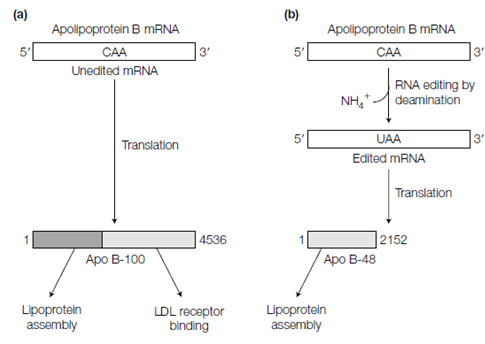RNA editing:
RNA editing is the name given to various reactions whereby the nucleotide sequence on an mRNA molecule should be modified through mechanisms other than RNA splicing. The Individual nucleotides within the mRNA should be modify to other nucleotides, erased entirely or additional nucleotides inserted. The result of RNA editing is to modify the coding capacity of the mRNA so in which it encodes a variant polypeptide than which really encoded through the gene. An instance of RNA editing in humans is apolipoprotein B mRNA and in liver, the mRNA does not undergo editing and the protein produced after translation is known as apolipoprotein B100 that shows in the figure. In cells of the little intestine, RNA editing causes the conversion of a single C residue in the mRNA to U and in so doing, modify a codon for glutamine (CAA) to a termination codon UAA. The Subsequent translation of the edited mRNA yields the much shorter apolipoprotein B48 (48 percent of the size of apolipoprotein B100). This is not a trivial modify; apolipoprotein B48 lacks a protein domain required for receptor binding that apolipoprotein B100 possesses and therefore the functional activities of the two proteins are different. Several other cases of RNA editing are also known. The Trypanosome mitochondrial mRNAs for instance, undergo extensive RNA editing that results in over half of the uridines in the last mRNA being acquired by the editing procedure.

Figure: RNA editing. (a) Unedited apolipoprotein B mRNA is translated to yield ApoB-100, a 4536-amino acid long polypeptide with structural domains for lipoprotein assembly and receptor binding functions; (b) translation of the edited mRNA yields the shorter ApoB-48 which lacks the receptor binding domain.